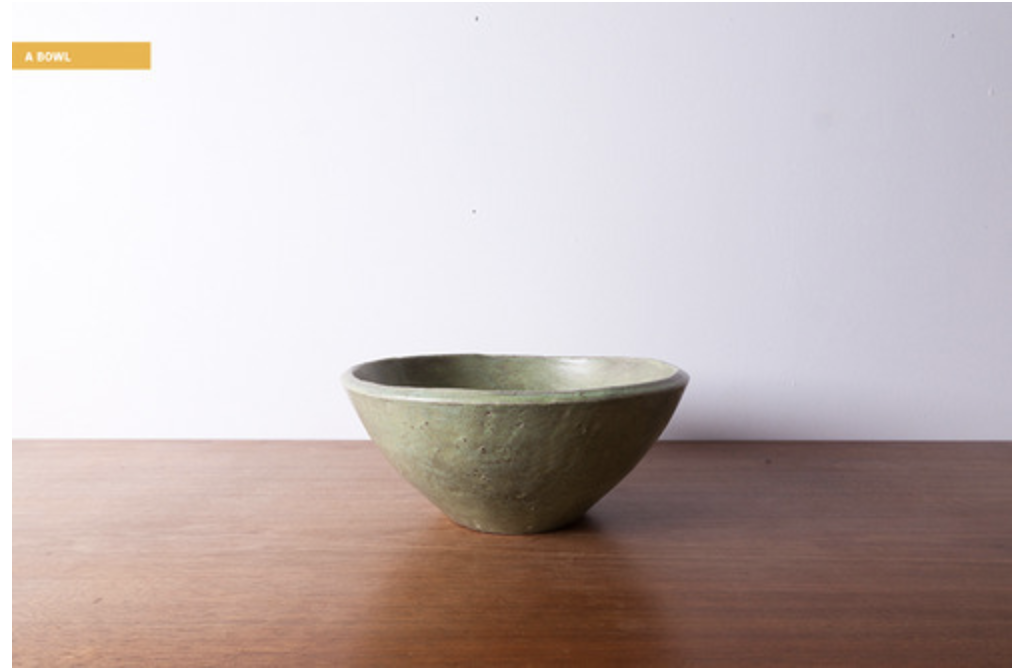object focus: the bowl
museum of contemporary craft
a bowl: common things
For this exhibition, we produced a Tumblr blog with stories, essays, videos, films, poems, drawings and more contributed by anyone who wanted to write about a bowl, the bowl, or my bowl.
Link: object focus: the bowl tumblr
Link: object focus: the bowl exhibition
Link: We Claim the Bowl in the Name of Craft (essay)
COMMON THINGS
Written by Namita Gupta Wiggers
In his Odes on Common Things, the Nobel prize-winning poet Pablo Neruda turns attention to objects which occupy daily lives: the broom, table, scissors, and plate. In his shift away from a focus on refined and rarefied human-made objects, Neruda, instead, uses the classical, lyrical form of the ode itself to examine the everyday. In contrast to John Keats’ Ode on a Grecian Urn (1819), for example, Neruda philosophizes about the luxury of handmade woolen socks on a cold winter day. In another ode, his description of the elegant, scrolled table of the wealthy man is economical and sparse; his words are spent, instead, on the simple four-legged quadruped upon which he writes, and around which he is joined by friends to share meals and plan revolutions.
Joe Pintz’s works, much like Neruda’s poems, call attention to the commonplace and overlooked. Pintz employs simple materials: his clay of choice is potting clay from a brick factory, clay that is minimally processed. The choice to use any type of clay determines the physical and aesthetic characteristics of the finished object. The clay Pintz employs will not produce fine, elegant lines and smooth surfaces associated with porcelain teacups. It is not a type of clay intended to be thrown, pulled, and shaped into vessels. It is dense and solid material, ideally suited for the carving and sculpting Pintz executes to create his objects. It is the form of clay that does the most work for humans: it creates the walls that shelter us from the elements. It is from this humble starting point that Pintz creates his own work.
Pintz’s objects are deceptively simple. Bold, chunky and oversized, Pintz draws our eyes to the sculptural qualities and physical forms of a specific category of objects. In their original forms, the muffin tray, ricer, and strainer, for example, are not objects that populate public spaces of a home. They are not vessels that hold flowers, or populate the shelves that flank a fireplace in the living room. The objects of Pintz’s focus belong to a category of tools that typically reside in the hidden recesses of cabinets, objects that are used and quickly returned to seclusion behind closed doors. Pintz magnifies the overlooked, bringing sculptural qualities of the tools of domestic work into view.
These new objects, sculptures and functional tableware created by Pintz, are self-assured in their occupation of space; the forms themselves are graphic and strong. Coupled with his unusual muted and washed surfaces, the works inhabit space in a curious way. By enlarging the objects beyond their expected dimensions, but retaining a human scale, Pintz creates sculptures that easily inhabit the pedestals and wall of the white cube as they do the tables and shelves of a home. Abstracted within the gallery environment, the planes, curves and surfaces of Pintz’s objects stand out. Within the privacy of the domestic space, Pintz’s works operate like Shaker chairs. When such chairs occupy walls in a modern home, they no longer serve their original functional purpose of saving space until needed. Instead, the Shaker chairs, and Pintz’s sculptures, shift into a sculptural and physical realm that is contingent on past use value, but simultaneously holds a different social and cultural value than the tool that served as a source of inspiration—a tool that remains secreted away from view. Pintz’s works add another twist by referencing and altering use in a way that continues to call attention to the everyday even when original functions are altered. For example, his sculpture that resembles a muffin tray might be hung on a wall as sculpture, or used as a container or serving tray.
It is on and at the table where Pintz’s examination of common things takes a decidedly contemporary and critical turn. The table, which Pablo Neruda maps as the surface and environment for revolution, is the most common place people consciously encounter objects made from clay in the form of dishes. Regardless of whether these dishes range from handmade to commercially produced, Pintz’s own tableware is stubbornly present yet simultaneously able to cohabitate the table with other objects. Pintz’s work denies easy polarization: it is not art or craft, decorative or sculptural, high or low, but all of these at the same time. While engagement with Pintz’s objects—whether at the table or in other spaces–could become habitual, the objects themselves disallow dismissal of the commonplace as vital and culturally significant.
This essay is an excerpt from an essay first published in Use: Keiko Narahashi and Joseph Pintz, Sheppard Gallery, University of Nevada, Reno, 2011
Namita Gupta Wiggers is Director and Chief Curator of Museum of Contemporary Craft, Portland, OR.
Image: Joseph Pintz, Large Serving Bowl, 2012, Ceramic and brick clay, 4 x 8 ½ inches diameter; Courtesy of the MoCC Gallery Store
Photo: Micah Fischer, ‘13
